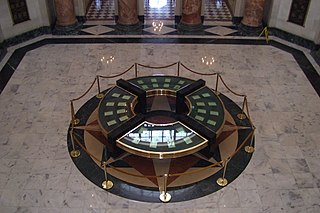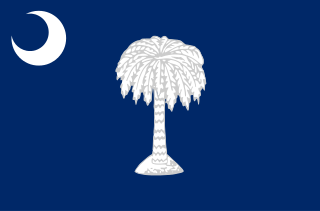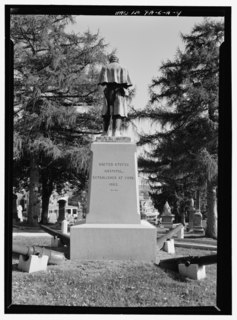Related Research Articles

The Presbyterian Church (USA), abbreviated PC(USA), is a mainline Protestant denomination in the United States. It is the largest Presbyterian denomination in the US, and known for its relatively progressive stance on doctrine and ordains women and LGBT community as elders and ministers. The PC(USA) was established by the 1983 merger of the Presbyterian Church in the United States, whose churches were located in the Southern and border states, with the United Presbyterian Church in the United States of America, whose congregations could be found in every state. The similarly named Presbyterian Church in America is a separate denomination whose congregations can also trace their history to the various schisms and mergers of Presbyterian churches in the United States. It supports evangelical feminism and supports practise of same gender marriages. It also welcomes gay and lesbian persons to serve in leadership positions as ministers, deacons, elders, and trustees.

The Constitution of the Commonwealth of Puerto Rico is the controlling government document of Puerto Rico. It is composed of nine articles detailing the structure of the government as well as the function of several of its institutions. The document also contains an extensive and specific bill of rights. It was ratified by Puerto Rico's electorate in a referendum on March 3, 1952, and on July 25, 1952, Governor Luis Muñoz Marín proclaimed that the constitution was in effect. July 25 is known as Constitution Day.

The Second Continental Congress was a meeting of delegates from the Thirteen Colonies in America that united in the American Revolutionary War. It convened on May 10, 1775, with representatives from 12 of the colonies in Philadelphia, Pennsylvania, shortly after the Battles of Lexington and Concord, succeeding the First Continental Congress which met in Philadelphia from September 5 to October 26, 1774. The Second Congress functioned as a de facto national government at the outset of the Revolutionary War by raising armies, directing strategy, appointing diplomats, and writing petitions such as the Declaration of the Causes and Necessity of Taking Up Arms and the Olive Branch Petition. All thirteen colonies were represented by the time the Congress adopted the Lee Resolution which declared independence from Britain on July 2, 1776, and the congress agreed to the Declaration of Independence two days later.
The Orthodox Presbyterian Church (OPC) is a confessional Presbyterian denomination located primarily in the northern United States. It was founded by conservative members of the Presbyterian Church in the United States of America (PCUSA) who strongly objected to the Modernist theology during the 1930s. It has had an influence on evangelicalism far beyond its size.

The Presbyterian Church in the United States of America (PCUSA) was the first national Presbyterian denomination in the United States, existing from 1789 to 1958. In that year, the PCUSA merged with the United Presbyterian Church of North America, a denomination with roots in the Seceder and Covenanter traditions of Presbyterianism. The new church was named the United Presbyterian Church in the United States of America. It was a predecessor to the contemporary Presbyterian Church (USA).

The Reformed Presbyterian Church General Assembly (RPCGA) is a Presbyterian church body and conservative denomination in the United States established in 1991. The RPCGA was founded by members of the Reformed Presbyterian Church in the United States.

South Carolina was the first state to secede from the Union in December 1860, and was one of the founding member states of the Confederacy in February 1861. The bombardment of the beleaguered U.S. garrison at Fort Sumter in Charleston Harbor on April 12, 1861 is generally recognized as the first military engagement of the war. The retaking of Charleston in February of 1865, and raising the flag again at Fort Sumter, was used for the Union the symbol of victory.

The Report of 1800 was a resolution drafted by James Madison arguing for the sovereignty of the individual states under the United States Constitution and against the Alien and Sedition Acts. Adopted by the Virginia General Assembly in January 1800, the Report amends arguments from the 1798 Virginia Resolutions and attempts to resolve contemporary criticisms against the Resolutions. The Report was the last important explication of the Constitution produced before the 1817 Bonus Bill veto message by Madison, who has come to be regarded as the "Father of the Constitution."

The York U.S. Army Hospital was one of Pennsylvania's largest military hospitals during the American Civil War. It was established in York, Pennsylvania, to treat wounded and sick soldiers of the Union army.
Nullification, in United States constitutional history, is a legal theory that a state has the right to nullify, or invalidate, any federal laws which that state has deemed unconstitutional with respect to the United States Constitution. The theory of nullification has never been legally upheld by federal courts.
The Preamble to the Constitution of India presents the principles of the Constitution and indicates the sources of its authority It was adopted on 26 November 1949 by the Constituent Assembly and came into effect on 26 January 1950, celebrated as the Republic day in India.

The Old School–New School Controversy was a schism of the Presbyterian Church in the United States of America which took place in 1837 and lasted for over 20 years. The Old School, led by Charles Hodge of Princeton Theological Seminary, was much more conservative theologically and did not support the revival movement. It called for traditional Calvinist orthodoxy as outlined in the Westminster standards.

Gardiner Spring was an American minister and author.

On December 8, 1941, the United States Congress declared war on the Empire of Japan in response to that country's surprise attack on Pearl Harbor and declaration of war the prior day. It was formulated an hour after the Infamy Speech of President Franklin D. Roosevelt. Following the U.S. declaration, Japan's allies, Germany and Italy, declared war on the United States, bringing the United States fully into World War II.
The Mississippi Secession Ordinance was written by Lucius Quintus Cincinnatus Lamar (II), who resigned from the U.S. Congress in January 1861. The ordinance was signed by James Z. George and others.

The 1917 United States declaration of war on Austria-Hungary, officially House Joint Resolution 169, was a resolution adopted by the United States Congress declaring that a state of war existed between the United States of America and the Austro-Hungarian Empire. It occurred eight months after the earlier declaration of war against Germany that had brought the United States into World War I. Enacted on December 7, 1917 and coming into effect the same day, it was officially terminated in 1921, three years after the effective capitulation of Austria-Hungary.

The Virginia Secession Convention of 1861 was called in Richmond to determine whether Virginia would secede from the United States, to govern the state during a state of emergency, and to write a new Constitution for Virginia, which was subsequently voted down in referendum under the Confederate Government.
The First North Carolina Provincial Congress was the first of five extra-legal unicameral bodies that met beginning in the summer of 1774. They were modeled after the colonial lower house. These congresses created a government structure, issued bills of credit to pay for the movement, and organized an army for defense, in preparation for the state of North Carolina. This First Congress met in New Bern from August 25 to August 27, 1774. John Harvey served as president. These Provincial congresses paved the way for the first meeting of the North Carolina General Assembly on April 7, 1777 in New Bern, North Carolina.
The First Woman's National Temperance Convention was a founding event in the establishment of the Woman's Christian Temperance Union (WCTU).
References
- 1 2 "Gardiner Spring Resolutions (1861)".
- ↑ William Thomas Hutchinson (1935). Cyrus Hall McCormick: Harvest, 1856–1884. 2. New York: D. Appleton, The Century Company.